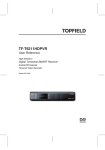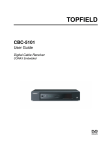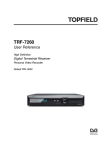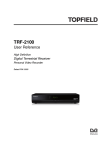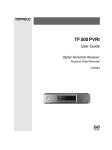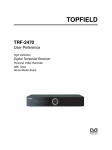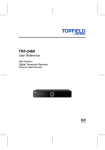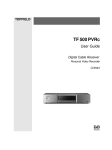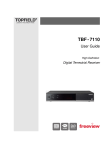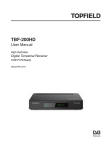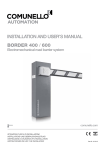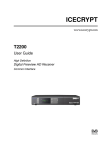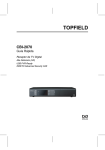Download TF-T6211HDPVR
Transcript
TF-T6211HDPVR User Reference High Definition Digital Terrestrial SMART Receiver Android OS Featured Personal Video Recorder Default PIN: 0000 ii The lightning flash with arrowhead symbol, in an equilateral triangle, is intended to alert the user to the presence of uninsulated “dangerous voltage” within the product’s enclosure that may be of sufficient magnitude to constitute a risk of electric shock to a person. The exclamation point, in an equilateral triangle, is intended to alert the user to the presence of important operation and maintenance instructions in the literature accompanying the product. Precautions • • • • • • • • • • • • • • Read, keep and follow these instructions. Clean with a dry cloth only. Do not block any of the ventilation openings. Do not install near any heat sources or in direct sunlight as this will impair cooling. Do not operate this product near water. Do not place any of the objects filled with liquids, such as vases on this unit. Do not try to change the plug or defeat its safety purpose. If the provided plug does not fit into your outlet, consult an electrician for replacement of the obsolete outlet. This product is designed for indoor use only. Place the digital receiver on a firm and level surface. Do not lay any objects such as magazines on this unit. Do not overload power outlets. Doing so may result in a risk of fire or electrical shock. Never open this unit’s casing under any circumstances, or the warranty will be void. Unplug this unit during lightning storms or when unused for long periods of time. Refer all servicing to qualified service personnel. Servicing is required when the unit has been damaged in any way, such as power supply cord or plug is damaged, liquid has been spilled or objects have fallen into the unit, the unit became wet from rain or moisture, does not operate normally, or has been dropped. Batteries, including those which contain no heavy metals, may not be disposed with other household wastes. Please dispose of used batteries in an environmentally sound manner. Find out the legal regulations which apply in your area. iii About this User Reference Thank you for purchasing our digital receiver. Please read this User Reference carefully before you use the digital receiver and keep it handy for future reference. This User Reference covers the model TF-T6211HDPVR. • Illustrations pictured in this reference may not be exactly the same as the actual product. • The screenshots used in this reference may not be exactly the same as those you see on the actual on-screen displays. • out any notice in order to introduce new features or improve the functionality of the product. 1. Connect the aerial antenna to the ANT IN nectors. (Composite, Component, HDMI) 3. Plug into power point and tur d unit ON using the switch on the back of the unit. 4. Switch television on, then use the television remote to select the correct video input channel for (for example, AV1, AV2, Component, HDMI, etc) 5. On the main menu go to Installation > Searching then scroll to Start Search and press OK . Wait till the progress bar on the bottom of the screen reaches 100 % and then press OK to save and EXIT to exit. The TF RCU app for Smart Phone Download the TF RCU app to control this unit with your smart phone. The RCU application is available to download from the *App Store or **Google Play Store. * App Store is a registered trademark of Apple, Inc. ** Google Play is a trademark of Google Inc. iv CONTENTS Contents Contents 1 . . . . . . . . . . . . . . . . . . . . . . . . . . . . . . . . . . . . . . . . . . . . . . . . . . . . . . . . . . . . . . . . . . . . 1 1 2 2 3 Setup 2.1 Unpacking . . . . . . . . . . . . . . . . . 2.2 Safety precautions . . . . . . . . . . . . 2.3 Rear panel connections . . . . . . . . . . 2.4 Connecting up your digital receiver . . . 2.4.1 Connecting to the antenna . . . 2.4.2 Connecting to your television set 2.4.3 Connecting to an external device 2.5 Switching ON for the first time . . . . . . . . . . . . . . . . . . . . . . . . . . . . . . . . . . . . . . . . . . . . . . . . . . . . . . . . . . . . . . . . . . . . . . . . . . . . . . . . . . . . . . . . . . . . . . . . . . . . . . . . . . . . . . . . . . . . . . . . . . . . . . . . . . . . . 5 5 5 6 8 8 8 10 11 3 Service Search 3.1 Searching for broadcasting services . . . . . . . . . . . . . . . . . . . 3.2 Reset to factory settings . . . . . . . . . . . . . . . . . . . . . . . . . 3.3 Reset service list . . . . . . . . . . . . . . . . . . . . . . . . . . . . . . 12 12 13 13 4 Preference Settings 4.1 Video and audio settings . . . . . 4.1.1 High definition television 4.1.2 Television aspect ratio . . 4.1.3 Audio mode . . . . . . . 4.2 Local time setting . . . . . . . . . 4.3 Parental control . . . . . . . . . . 4.4 Options for recording . . . . . . . 14 14 14 15 16 16 17 18 2 Introduction 1.1 Features . . . . . . . . . . . . . 1.2 Controlling the digital receiver 1.2.1 Front panel . . . . . . . 1.2.2 Remote control . . . . . iv . . . . . . . . . . . . . . . . . . . . . . . . . . . . . . . . . . . . . . . . . . . . . . . . . . . . . . . . . . . . . . . . . . . . . . . . . . . . . . . . . . . . . . . . . . . . . . . . . . . . . . . . . . . . . . . . . . . . . . . . . . . . . . . . . . . . . . . . . . . . . . . . . . . . . . . . . . . . CONTENTS v 4.5 4.6 4.7 4.8 Options for playback . . . . . Options for on-screen display Options for the front display . Options for Photo Album . . . . . . . . . . . . . . . . . . . . . . . . . . . . . . . . . . . . . . . . . . . . . . . . . . . . . . . . . . . . . . . . . . . . . . . . . . . . . . . . . . . . . . . . . . 19 19 20 20 5 Every Day Use 5.1 Volume control . . . . . . . . . . . . . . . 5.2 Watching television . . . . . . . . . . . . . 5.2.1 The services list . . . . . . . . . . 5.2.2 The favourite service lists . . . . . 5.2.3 Viewing programme information 5.2.4 Selecting audio tracks . . . . . . . 5.2.5 Selecting subtitle tracks . . . . . . 5.3 Viewing electronic programme guide . . . 5.4 Using time-shift . . . . . . . . . . . . . . . . . . . . . . . . . . . . . . . . . . . . . . . . . . . . . . . . . . . . . . . . . . . . . . . . . . . . . . . . . . . . . . . . . . . . . . . . . . . . . . . . . . . . . . . . . . . . . . . . . . . . . . . . . . . . . . . . . . . . . . . . . . . . . . . . . . . . . . 21 21 21 21 22 23 23 23 24 25 6 Organising Services 6.1 Editing the favourite lists . . . . . . . . . . . . . . . . . . . . . . . . . 26 26 7 Recording and Playback 7.1 Recording a programme . . . . . . . . . . . . . . . . . . . . 7.1.1 Instant recording . . . . . . . . . . . . . . . . . . . 7.1.2 Timer recording . . . . . . . . . . . . . . . . . . . . 7.1.3 Scheduling recordings using the programme guide 7.1.4 Recording a time-shifted programme . . . . . . . . 7.2 File archive . . . . . . . . . . . . . . . . . . . . . . . . . . . 7.2.1 To delete a recording . . . . . . . . . . . . . . . . . 7.2.2 To sort recordings . . . . . . . . . . . . . . . . . . . 7.2.3 To lock a recording . . . . . . . . . . . . . . . . . . 7.2.4 To rename a recording . . . . . . . . . . . . . . . . 7.2.5 To make a new folder . . . . . . . . . . . . . . . . . 7.2.6 To move a recording to another folder . . . . . . . . 7.3 Playing back a recording . . . . . . . . . . . . . . . . . . . . 7.3.1 To navigate using the progress bar . . . . . . . . . . 7.3.2 To play in slow motion . . . . . . . . . . . . . . . . 7.3.3 To play in fast motion . . . . . . . . . . . . . . . . . 7.3.4 To make a bookmark . . . . . . . . . . . . . . . . . 7.4 Copying a recorded file . . . . . . . . . . . . . . . . . . . . . 7.5 Transcoding a recorded file . . . . . . . . . . . . . . . . . . 7.6 Formatting the hard disk . . . . . . . . . . . . . . . . . . . . 28 29 29 30 32 33 33 33 33 34 34 34 34 34 35 35 36 36 36 37 38 . . . . . . . . . . . . . . . . . . . . . . . . . . . . . . . . . . . . . . . . . . . . . . . . . . . . . . . . . . . . . . . . . . . . . . . . . . . . . . . . . . . . . . . . . . . . . . . . . . . . vi CONTENTS 8 Accessing via Network 8.1 g the router . . . . . . . . . . . . . . 8.1.1 To access within the local area network 8.1.2 To access over the Internet . . . . . . . 8.2 Network setup . . . . . . . . . . . . . . . . . . 8.2.1 For a wired connection . . . . . . . . . 8.2.2 For a wireless connection . . . . . . . . . . . . . . 39 40 40 40 41 41 41 9 Firmware Update 9.1 From a memory stick . . . . . . . . . . . . . . . . . . . . . . . . . . . . 44 44 A Troubleshooting . . . . . . . . . . . . . . . . . . . . . . . . . . . . . . . . . . . . . . . . . . . . . . . . . . . . . . . . . . . . . . . . . . 45 Chapter 1 Introduction The TF-T6211 digital receiver is fully compliant with the international Digital Video Broadcasting (DVB) standard, and thus is able to receive digital broadcasts of that standard. For its operation you need an antenna, which must be installed appropriately. NOTE The frequency in digital broadcasting is usually called transponder or multiplex. To reduce confusion in this manual, the word service is preferably used than channel as a term to indicate one television or radio broadcast. 1.1 Features This digital receiver has the following features: • Can store up to 2,000 television and radio services. • Can create lists of your favourite services. • You can record programmes using a built-in hard drive with large storage capacity. • Time-shift is a special technical feature available on this digital receiver. You can pause a programme you are watching and resume it again at a later time. Then you can quickly go to any part of the current programme by fast forward or rewind search. • If you have an external hard drive connected to the digital receiver via USB, you can record programmes into it. • Encode recorded contents to view on other portable devices. 1 Introduction 1 2 Introduction • You can use various web services including YouTube. • You can use the web browser to view online contents. • You can share media files with other device across the same home network. 1.2 Controlling the digital receiver You can operate the digital receiver with the remote control or the buttons on the front panel. NOTE Even when you are not using the digital receiver, you should keep it plugged into a wall socket to be in standby mode so that it can run timer events at any time. 1.2.1 Front panel The front panel of the digital receiver has buttons to control the digital receiver, specific lights and a display to indicate its status. switches the digital receiver between standby mode and active mode. Front display shows the current time in standby mode, and displays the current service in active mode. CH, CH switch to previous/next service. 1.2.2 Remote control • button switches the digital receiver between standby/active mode. • mutes the sound. Press again to switch it back on. • changes video resolution. • changes aspect ratio. • not used in this model. • switches over between television services and radio services. • Numeric buttons are used to enter a service number for service change or to specify values for menu options. • • switches over between the current service and the previously viewed one. displays the service information box. Also, displays more information about a programme. • (white button) has • selects subtitle track. • not used in this model. • selects audio track or sound mode. • add channel to favourite channels list. • displays the electronic programme guide. • , buttons switch to the previous or next service. Also, navigate in menus and interactive screens displays the services list. Also, selects menu items. • • t functions per menu. , buttons decrease or increase the volume. Also, change values for menu options. • displays the main menu. Also, returns to the previous menu from a submenu. • exits a menu or hides on-screen information. 1 Introduction 1.2 Controlling the digital receiver 3 4 Introduction • V− , V+ buttons decrease or increase the volume. • sets a sleep timer in 10 minute increments. • displays the list of recorded programmes that are stored in the external hard drive. • P− , P+ buttons switch to the previous or next service. has • t functions per menu. • starts recording. • stops playback, recording, or jumps back to live television from time-shifted television. • has • change to mouse mode (using • starts reverse playback. Subsequent presses increase the rewind speed. • pauses live television or playback of a recorded programme. • resumes normal playback speed, or displays the progress bar for navigation on playback or time-shift. • starts fast forward playback. Subsequent presses increase the playback speed. • jumps back to the beginning of the recording during playback. • starts slow motion playback. Subsequent presses change the playback speed. • set repeat playback for recorded program playback. • jumps to the end of the recording during playback. t functions per menu. navigation buttons) * Functions of the colour buttons will be guided on the screen. 5 2 Setup Chapter 2 Setup 2.1 Unpacking Before going any further, check that you have received the following items with the digital receiver. • • • • Remote control Two batteries for the remote control (AAA 1.5 V) One HDMI cable A copy of the User Manual NOTE Accessories may vary according to your local area. 2.2 Safety precautions Please read carefully the following safety precautions. • The mains voltage must range between 90 and 250 volts. Check it before plugging the digital receiver to the wall socket. For the power consumption of the digital receiver, refer to Table 2.1. • The wall socket should be near the equipment. Do not run an extension lead to the unit. • The mains plug shall remain readily operable so that it can be removed easily to disconnect the power. • When placed in a cabinet, make sure there is a minimum space of 10 centimetres around it. For the physical specification of the digital receiver, refer to Table 2.2. 6 Setup • Protect the power cord from being walked on or pinched. If the cord is damaged, do not use the digital receiver and get the cord replaced. • Refer all servicing to a d service technician. • To maintain proper ventilation, always leave t space around the digital receiver. Table 2.1: Power Input voltage Power consumption 90 to 250 V AC, 50/60 Hz 18 W at maximum in active Under 1W in passive standby Table 2.2: Physical Size Weight(Net) Operating temperature Storage relative humidity 260 × 46 × 190mm 1.9 kg 0 to 45 ◦ C 5 to 90 % 2.3 Rear panel connections Check what connections your television set has in comparison with the digital receiver. ANT IN Terrestrial broadcasting signal input socket (5V, Max.100mA) RF LOOP OUT Terrestrial broadcasting signal output socket through the ANT IN socket for other receiver S/PDIF HDMI Digital audio output socket for the audio-video receiver 2.3 Rear panel connections / (USB 2.0Host, 5VDC, 500mA Max.) VIDEO Composite video output socket for the television set (yellow) AUDIO L/R Stereo audio output socket for television or audio receiver (white/red) LAN Local area network port DC IN Power jack Table 2.3: Connectors specifications VIDEO AUDIO Composite video (CVBS) output Left & right audio output S/PDIF HDMI Dolby Digital audio output High definition video output Left & right audio output USB LAN 2.0 Host (5 V DC, 500 mA) 10/100 Ethernet 2 Setup USB 7 8 Setup 2.4 Connecting up your digital receiver There are several ways to set up the digital receiver. Set up the digital receiver suitably to your television and other devices. If you have any problem with your setup or need help, contact your dealer. WARNING Connect any components before plugging the power cord into the wall outlet. Always turn off the product, TV and other components before you connect or disconnect any cables. NOTE If you encounter any problems setting up your product, please contact your local retailer. 2.4.1 Connecting to the antenna Whatever sort of connection you have between the digital receiver and the television, you need to connect the digital receiver to the antenna so that it can receive digital television broadcasts. Connect the antenna cable to the ANT IN connector. If you have another digital receiver, you may link it from the RF LOOP OUT connector. NOTE RF LOOP OUT may also be linked to your television, VCR, or DVD recorder to loop an analogue signal. 2.4.2 Connecting to your television set For all the following connections of the digital receiver, we recommend you to use the first connector to get the best picture quality. If your television does not have a matching connector, then use the next connector in the following order for a better picture quality. 1. HDMI connector (HDMI) 2. Composite connector (VIDEO) You should configure audio and video settings after connecting up the digital receiver. See §4.1 for a detailed description. 2.4 Connecting up your digital receiver 9 If you have a high definition television set, you should use an HDMI cable for best results. Plug one end of the cable into the HDMI socket on the digital receiver, and plug the other end into the matching socket on your television. In this case, you do not have to make audio connection because it can output stereo audio or digital audio as well. To use the Composite video output You need to obtain a Composite video cable (RCA cable) to use the Composite video output. Plug one end of the cable into the VIDEO (yellow) socket on the digital receiver, and plug the other end into the matching socket on your television. NOTE You cannot view high definition video by means of the Composite video output. 2 Setup To use the HDMI output 10 Setup To make the audio connection You need to obtain an audio cable (RCA cable) to link the audio connectors. Plug one end of the cable into the AUDIO L (white) and AUDIO R (red) sockets on the digital receiver, and plug the other ends into the matching sockets on your television or audio-video receiver. To enjoy Dolby Digital audio, your television or audiovideo receiver must be able to decode Dolby Digital audio, and you need to obtain a S/PDIF cable. Plug one end of the cable into the S/PDIF socket on the digital receiver, and plug the other end into the matching socket on your audio-video receiver. 2.4.3 Connecting to an external device The digital receiver can also present or record the video from an external device such as a DVD player through the Composite connector. You need a Composite cable (RCA cable) to use the Composite connector. Plug one end of the cable into the VIDEO (yellow), AUDIO L (white) and AUDIO R (red) sockets on the digital receiver, and plug the other end into the matching socket on your video recorder or suchlike. 2.5 Switching ON for the first time 11 2 2.5 Switching ON for the first time button on the top left corner on the remote control. In a Press the little time, you may see a picture displaying a menu. If you do not see a picture, try pressing the VF button on the remote control. If after several tries you still get no picture, check that the television is set to the correct input. If the picture is good, you can skip to §3.1 to search for available television and radio services. Otherwise, you may need to temporarily connect the Composite video connector (VIDEO) to your television set so that you can see the menu in order to configure the video settings. CAUTION If the digital receiver no longer reacts properly to the remote control commands, the batteries may be flat. Be sure to replace only with 1.5 V AAA size batteries, and observe the following precautions. • Do not mix different types of batteries, or new and old batteries. • Do not use rechargeable batteries. • Do not recharge the old batteries. • In order to avoid any risk of explosion, observe the polarities indicated inside the battery compartment. • Do not subject to excessive heat such as the sun and fire. • If you are not using the remote control for a long period of time, remove the batteries. The manufacturer accepts no liability for the damage resulting from leaking batteries. • Batteries, including those which contain no heavy metals, may not be disposed with other household wastes. Please dispose of used batteries in an environmentally sound manner. Find out the legal regulations which apply in your area. Setup Now that you have your digital receiver connected, you should plug it into a wall socket. Ensure that your television set is turned on and on the correct video channel so that you will be able to see the display from the digital receiver. 12 Service Search Chapter 3 Service Search After connecting up the digital receiver, you will need to perform a service search. NOTE If there is no service stored, you will be not able to access all menus. A service is another name for a channel. 3.1 Searching for broadcasting services To perform service search, select the Installation > Searching menu. You should see a screen like the left figure. You should set the Search Mode option to Auto for the first time after connecting up the digital receiver. You may choose to only search for the services of a specific transponder since more than one service are provided via each transponder. Set the Search Mode option to Manual, then select your desired transponder at the Channel option. The number ranges from 6 to 12 in VHF and 28 to 69 in UHF. 3.2 Reset to factory settings 13 3.2 Reset to factory settings The digital receiver maintains the following data: • • • • Services list Favourite list Timer list Preference settings You can reset all data of the digital receiver. Select the Installation > System Recovery > Factory Setting menu, and then you get asked for confirmation. With the choice of Yes, the services list, favourite list and timer list will all be cleared, and preference options will be reset to the manufacturer’s factory settings. NOTE A factory reset will not delete any recorded programmes. However, you have to search services again after a factory reset. 3.3 Reset service list If you only want to clear the service list, select Installation > System Recovery > Reset Service List , then you get asked for confirmation. With the choice of Yes, the services list will be cleared. After this, you have to do service search again. 3 Service Search To start service search, move down to the Start Search item, and press the OK button. The digital receiver will start to search for services. It is common for no channels to be found until quite late in the process. When the scan is complete, you will see a message telling you how many services have been found. Press the OK button to save the list. 14 Preference Settings Chapter 4 Preference Settings 4.1 Video and audio settings You have to configure the video and audio settings appropriately for your television set and other devices. Select the Settings > A/V Output menu. You should see a screen like the left figure. 4.1.1 High definition television The digital receiver supports various video resolutions from 576 to 1080. In general, a resolution of 720 or more is considered high definition. The higher the resolution is, the better the quality is. However, if your television set does not support high definition, you cannot enjoy high definition quality picture. Set the Video Format option as you desire. If you set this option to 576P, the digital receiver will present even high definition programmes in resolution of 576. On the contrary, if you set it to 1080I, the digital receiver will present even standard definition programmes in resolution of 1080. While watching television you can change the resolution with the button. Whenever you press it, the video resolution is changed in turn. NOTE You can enjoy only standard definition video with the following video outputs: • Composite video output (VIDEO) 4.1 Video and audio settings 15 4.1.2 Television aspect ratio You cannot fully enjoy wide-screen programmes with your normalscreen television as the above figures show. The left figure shows a normal picture displayed in the normal screen. To watch wide-screen programmes in the shape like the centre figure, set the Display Format option to Letter Box. Wide-screen pictures then will be reduced to fit to the width of the normal screen. Otherwise, to watch them in the shape like the right figure, set it to Center extract. Then wide-screen pictures will be cut out on the left and right sides equally to fit to the width of the normal screen. Preference Settings You can enjoy both wide-screen programmes and normal-screen programmes with your wide-screen television as the above figures show. To watch normal-screen programmes in full screen like the left figure, set the Display Format option to Full. Normal-screen pictures then will be inflated to fit to the width of the wide screen. Otherwise, to watch them in the original ratio like the right figure, set it to Center. If you have a normal-screen television, set the TV Aspect Ratio option to 4:3. 4 If you have a wide-screen television, set the TV Aspect Ratio option to 16:9. 16 Preference Settings 4.1.3 Audio mode Basically, there are two audio sources as you can find two audio sockets on the back panel of the digital receiver. You can enjoy only one source or both of them in either stereo or mono. Set the Sound Mode option as you desire. Apart from this setting, you can change the sound mode with the button. See §5.2.4 for a detailed description. The digital receiver can output two types of digital audio signals via the S/PDIF output. One is an encoded signal, and the other is a decoded signal. If you have the digital receiver linked to your audiovideo receiver via the S/PDIF output, you have to set the Dolby Digital option to PCM, which means that the digital receiver will output encoded Dolby Digital audio without decoding so that your audio-video receiver can decode it. Otherwise, set it to multi-channel, then the digital receiver will output decoded Dolby Digital audio, scaling it down to two channels. NOTE Only if the service you are currently watching provides a Dolby Digital audio track, you can enjoy Dolby Digital sound. 4.2 Local time setting You should set your local time for timer events. Select the Settings > Time menu. You can set the clock manually or by Greenwich Mean Time (GMT). To use Greenwich Mean Time, take the following steps: 1. Set the Mode to Auto, then the Time Offset will be enabled. 2. Set the Time Offset option to the time difference between your time zone and GMT referring to Table 4.1. 3. Make sure the correct time is displayed on the Local Time area. To set the local time manually, set Mode to Manual and enter the correct time to the Local Time option with the numeric buttons. The time format is day/month/year 24-hour:minute. 4.3 Parental control 17 Table 4.1: Time offset table Time offset City 4 GMT − 12:00 GMT − 11:00 GMT − 10:00 GMT − 09:00 GMT − 08:00 GMT − 07:00 GMT − 06:00 GMT − 05:00 GMT − 04:00 GMT − 03:30 GMT − 03:00 GMT − 02:00 GMT − 01:00 GMT GMT + 1:00 GMT + 2:00 GMT + 3:00 GMT + 3:30 GMT + 4:00 GMT + 4:30 GMT + 5:00 GMT + 5:30 GMT + 6:00 GMT + 7:00 GMT + 8:00 GMT + 9:00 GMT + 9:30 GMT + 10:00 GMT + 11:00 GMT + 12:00 Eniwetok, Kwajalein Midway Island, Samoa Hawaii Alaska Pacific Time US, Canada Mountain Time US, Canada Central Time US, Canada, Mexico City Eastern Time US, Canada, Bogota, Lima Atlantic Time Canada, La Paz, Dominican Republic Newfoundland Brazil, Georgetown, Buenos Aires Mid-Atlantic Azores, Cape Verde Islands London, Lisbon, Casablanca Paris, Brussels, Copenhagen, Madrid South Africa, Kaliningrad Baghdad, Riyadh, Moscow, St. Petersburg Tehran Abu Dhabi, Muscat, Baku, Tbilisi Kabul Ekaterinburg, Islamabad, Karachi, Tashkent Bombay, Calcutta, Madras, New Delhi Almaty, Dhaka, Colombo Bangkok, Hanoi, Jakarta Beijing, Perth, Singapore, Hong Kong Tokyo, Seoul, Osaka, Sapporo, Yakutsk Adelaide, Darwin Eastern Australia, Guam, Vladivostok Magadan, Solomon Islands, New Caledonia Fiji, Auckland, Wellington, Kamchatka Preference Settings 4.3 Parental control In general, television programmes are classified according to the level of violence, nudity and language of their content. When you are watching a programme, you can check its programme classification on the information box. For the information box, see §5.2.3. You can prevent your children from watching specific programmes by specifying a maximum permissible level. Select the Settings > Parental Control menu. You will be asked for your Personal Identification Number (PIN). The number is initially set to ‘0000’ as default. To block programmes with undesired content for family viewing, set the Censorship option to your desired level among the following: 18 Preference Settings No block restricts no prorgramme. Total block restricts every programme, even those with no programme classification. G restricts to G or above. G rated programmes are suitable for all audiences. PG restricts to PG or above rated programmes. PG stands for Parental Guidance, the content of which is mild. M restricts to M or above rated programmes. M stands for Mature, the content of which is moderate in impact. MA restricts to MA or above rated programmes. MA stands for Mature Audience, the content of which is strong. R restricts to R rated programmes. R stands for Restricted to adults aged 18 years or over, the content of which is very strong. AV restricts to AV rated programmes. AV stands for Adult Viewing, the content of which is deep hardcore. NOTE If a programme has no rating information, your censorship setting will not take effect. If anyone is trying to watch a programme that is of or above the censorship setting, the person has to enter the personal identification number to override. To change the number, select the Change PIN Code menu, then a box pops up, asking a new PIN. Enter a desired number twice for confirmation. You can also restrict uses of some menus. Selecting the Access Control menu displays a list of menus that you can lock. If the Time item is set to Locked, you have to enter the PIN when accessing the Time menu. If you enter a wrong number, you cannot use the menu. To release a locked item, set it to Unlocked. 4.4 Options for recording To set the options for recording, select the Settings > Recording menu. To enable the time-shift function, you should set the Time Shifting option to anything other than Disable. The available range for this option is 30 minutes to 5 hours. You will have the latest of the current programme as long as the duration specified at this option. You can record a programme into both an external and the built-in hard drive. If you want to record a programme into an external hard drive, set Recording Drive option to External; otherwise, set this option to Internal. If you set the Time Shift Storage option to Enable, the 4.5 Options for playback 19 Time padding is the feature of adding extra recording time to the beginning or end of a programme, so that you do not miss any part of the programme. Set the Timer Record Padding option as you desire. You can adjust the duration of the instant recording. Set the Instant Recording Duration option as you desire. Its available range is 30 minutes to 5 hours. 4.5 Options for playback To set the options for playback, select the Settings > Playback menu. If you want to play back a recorded file from beginning, set Starting Position option to Beginning. To play back a recorded file from the part where you were watching, set this option to Continuing. If you want to enjoy more levels of playback speed, set the Trick Mode Level option to 2x, 4x, 8x, 16x, 32x, 64x, 128x; otherwise, set it to 4x, 16x, 64x, 128x. 4.6 Options for on-screen display To set the options for the on-screen display (OSD), select the Settings > OSD menu. To adjust the transparency level of the OSD, set the OSD Transparency option as you desire. Its available range is 0 to 50 percent. To adjust the display time of the information box, set the Info Box Display Time option as you desire. Its available range is 1 to 30 seconds. If you set this option to No Info Box, the information box will not be displayed when you switch services. However, pressing the button will display the information box. If you set this option to Never Hide, the information box will always be displayed. For the information box, see §5.2.3. If any service’s name is too long to fit the width of the service name column on the services list screen, you can get it to scroll by setting the Text Scroll option to anything other than Disable. With the choice of Full Scroll, it will be fully scrolled until its end disappears; with the choice of Part Scroll, it will be scrolled only to its end. Preference Settings You can set the duration of the timer recording. Set the Timer Recording Duration option as you desire. Its available range is 10 minutes to 3 hours. 4 time-shifted programme will be saved in the TimeShift folder of the hard drive. 20 Preference Settings 4.7 Options for the front display To set the options for the front display, select the Settings > Front Display menu. The front display shows the currently viewed service’s number and name. If any service’s name is too long to fit the width of the service name column, you can get it to scroll by setting the Main Display Scrolling option to anything other than Disable. With the choice of Unlimited, it will be repeatedly scrolled; with the choice of Once, it will be scrolled only once. If you want to have the current time displayed instead of the service number, set the Sub Display Content option to Time. You can also adjust the brightness of the front display in active mode and standby mode by setting the Brightness in Operation Mode option and the Brightness in Standby Mode option to any as you like. 4.8 Options for Photo Album You can change a time interval and effect of slideshow in the photo album. For the photo album feature, see §8.3. To change the time interval of slideshow, select the Settings > Miscellaneous menu, and then set the Slideshow Time Interval option as you desire. Its available range is 3 to 10 seconds. 21 Every Day Use 5.1 Volume control Use the V - or V+ buttons to alter the volume to a comfortable level. 5.2 Watching television To change services, press the P - or P+ button. In addition, you can switch to your desired service by entering its service number with the numeric buttons. 5.2.1 The services list To view the services list, press the OK button. On the services list, you can see the service information as follows: • Service number and name • Multiplex information To select a desired service, put the highlight bar on its entry with the 5 Every Day Use Chapter 5 22 Every Day Use or button and press the OK button, then the selected service will be presented. Pressing the or button skips over 10 entries up or down. Entering a service number with the numeric buttons puts the highlight bar on its entry. You can switch between the television services list and the radio serbutton. vices list by pressing the 5.2.2 The favourite service lists You can select a service on a favourite list as well as on the services list. To display the favourite lists, press the F2 button at the services list screen. For the services list, see §5.2.1. To select a favourite list, put the highlight bar on a desired favourite group list and press the OK button, then the selected favourite group’s services will be listed. As to how to edit the favourite lists, refer to §6.1. To select a favourite service, put the highlight bar on a desired service and press the OK button, then it will be displayed. To select another group, press the button. After you have selected a favourite service, if you then switch to another service using the or button, it will be also another favourite service of the selected group. The digital receiver will remind you what group you have selected by displaying its name at the top right of the screen whenever you switch services. To return to the services list, press the F1 button. Besides that, you can add or delete a favourite group or service. To add a new favorite group, press the F1 button to display additional options, and then select Add New Favorite Group. To add the service you are currently watching into a favourite group, press the F1 button to display additional options, and then select Add this service item. To remove the currently highlighted favourite grop or service, select Delete item in the additional option box, then you get asked for conrmation; with the choice of Yes, it will be removed. 5.2 Watching television 23 5.2.3 Viewing programme information Pressing the button displays the information box, on which you can see all of the following: Service number and name Transponder information Signal level and quality Programme name Programme classification sign Programme summary Broadcasting time Current time In addition, you might see the following symbols: • Subtitle symbol ( ) if subtitle tracks are provided on the current programme. • Dolby Digital symbol ( ) if a Dolby Digital audio track is provided on the current programme. ) if the current service is locked. • Lock symbol ( Pressing the button once more displays detailed information about the current programme. To hide the information box, press the button. 5.2.4 Selecting audio tracks Some programmes are provided with audio tracks in one or more languages. Pressing the button displays available audio tracks. Once you select an audio track, that track will be heard. In addition, you can enjoy audio tracks in four sound modes: Stereo, Mono, Left or Right. 5.2.5 Selecting subtitle tracks Some programmes are provided with subtitle tracks in one or more languages. If the current programme provides subtitle tracks, the subtitle symbol ( ) will be marked on the information box. Pressing the button displays available subtitle tracks. Once you select a subtitle track, it will be displayed. 5 Every Day Use • • • • • • • • 24 Every Day Use 5.3 Viewing electronic programme guide The Electronic Programme Guide (EPG) shows the current and scheduled programmes that are or will be available on each service with a short summary for each programme. Pressing the EPG button displays the electronic programme guide, on which you can see the following: • • • • Scheduled programmes programme summary Broadcasting date Broadcasting time To see detailed information of a desired programme, put the highlight bar on the programme with the or button and press the or button. ton. To switch to another service, press the but- You can travel over previous days with the F2 button, and can travel over next days with the F3 button. To see the programme guide for radio broadcasts, press the To switch it back, press the button. button again. Pressing the F1 button will rearrange the form, swapping the columns and rows. To switch it back, press the F1 button again. You can make a timer recording on the electronic programme guide. See §7.1.3 for detailed description. 5.4 Using time-shift 25 5.4 Using time-shift - 00:23 When you do this, you are no longer watching the live programme, instead you are watching a delayed presentation. This is called time-shifted television. You can skip commercials until you catch up to the live broadcast. In order to use the time-shift feature, set the Time Shifting option to desired duration of time. Then the digital receiver will archive the programme as much time as you set in the option. See §4.4. The time-shift will be reset each time you change to another service. With the time-shift, the following operations are possible: • To go back in time, hold down the F3 button; to go forward, hold down the F4 button. The progress bar is displayed momentarily with a preview window. • You can navigate using the progress bar, refer to §7.3.1. • You can jump backward and forward by pressing the F4 and F3 buttons. You can change the jump time at the Jump Time Interval option. See §4.5. • You can change playback speed. See §7.3.2 for slow motion. For fast motion, see §7.3.3. but• To check your current position in time-shift, press the ton. The time difference compared to live programme is displayed momentarily in top right corner of the screen. A value of −02:00 means two minutes behind the live programme. • To make a recording of the time-shifted programme„ see §7.1.4. • To end time-shift, press the EXIT button. The live programme will be displayed. 5 Every Day Use You can pause and resume a live television programme, and even rewind and replay it. When you are watching a programme and you miss something, you can rewind and replay it. Or when your attention is needed elsewhere, you can pause a live TV and resume a short time later without losing any of the programme. 26 Organising Services Chapter 6 Organising Services 6.1 Editing the favourite lists You can make your own favourite service lists. In fact, you can define multiple favourite service lists, each being a ‘group’ of chosen services. Select Installation > Edit Favorite List menu. You should see a screen like the left figure. There are three columns: • Group name (left) • Favourites list (centre) • Services list (right) The services list contains all available services, whereas the favourites list contains only chosen services that have been added to the highlighted group. As you move the highlight bar up or down on the group list, favourite services belonging to the highlighted group get shown in the favourites list. NOTE To load guide, go to the specific channel, press the EPG button, then the guide will populate. Do this to every single channel upon starting up PVR. 6.1 Editing the favourite lists 27 You can add up to 30 groups. To add a new group, select the NEW item in the group list, then the on-screen keyboard appears. To rename a group, put the highlight bar on the group entry you want and press the F2 button, then the on-screen keyboard likewise appears. 1. Put the highlight bar on a desired group entry in the group list and press the OK button to select it. The highlight bar then moves to the services list. 2. To add a service to the selected group,put the highlight bar on a desired service entry and press the OK button. The selected service entry gets added to the favourite list. Repeat this step to add more entries. 3. Press the F1 button, and the highlight bar gets moved to the favourite list. You can delete a favourite entry with the OK button. 4. To select another group, press the F1 button again, then the highlight bar gets moved to each column. Furthermore, you can rearrange a group’s favourites by moving a favourite entry. To move a favourite entry, put the highlight bar on the favourite entry you want and press the F2 button. Press the , buttons or , buttons to move it to a desired place and press the OK button. To add radio services, press the button, then radio service entries get listed in the services list. To recall the television services list after adding radio services, press the button again. As to how to use the favourite service lists you organised, refer to §5.2.2. Organising Services You can add a favourite service to a group by taking the following steps: 6 To delete a group, put the highlight bar on the group entry you want and press the F3 button, then a message box appears, asking you for confirmation. With the choice of Yes, it will be deleted. 28 Recording and Playback Chapter 7 Recording and Playback You can record TV programmes into an external hard drive as well as the built-in hard drive. NOTE To use an external hard drive, you must connect the external hard drive to the USB port of the digital receiver. You cannot play back the recordings with a regular MPEG player on your computer because they are formatted differently from the standard MPEG format. Visit http://www.kmplayer.com where you can find an MPEG player able to play them back. CAUTION Do not disconnect the external hard drive while recording or playing back. It may cause damage to recorded programmes. You should disconnect the external hard drive in standby mode only. Avoid transferring files while the unit is set to record. This recorder can record four channels simultaneously, however, this is controlled by the channel frequency. Each channel has other programmes under the one frequency (E.g. Channel Nine has 9, 9HD, GO, GEM) (Channel ABC has ABC News 24, ABC1, ABC2, ABC3, etc.). This recorder can record four programmes locked on two channel frequencies simutaneously. (E.g. 10.TEN Digital plus 11.One HD and 90.GEM plus 99.Go!) While recording the above combination of programmes you can also playback a pre-recorded show. 7.1 Recording a programme 29 7.1 Recording a programme Once a recording gets started, a symbol like the left figure will be displayed at the top right of the screen for a few seconds. For example, if you record channel 7TWO and channel 9 Digital, you have locked the first tuner into all the channels from 7 which includes: 7 Digital, 7 Digital 1, 7TWO and 7Mate. While on the second tuner you have locked in all the channels from 9 which includes: 9 Digital, Gem and Go. With this in mind, while the above two channels (eg. 7TWO and 9 Digital) are being recorded, you can watch a third channel which can be only one of the following: 7 Digital, 7 Digital 1, 7Mate, Gem or Go. The same can be said for recording for four channels (eg. 7TWO, 7Mate, 9 Digital and Go). You can watch an additional channel which can be only one of the following: 7 Digital, 7 Digital 1 or Gem. CAUTION Do not move the digital receiver nor pull out the power plug while it is running. It may cause damage to recorded programmes. Topfield is not responsible for damages inflicted on files that are stored on the hard drive. 7.1.1 Instant recording To instantly record a programme you are watching at present, press the button. If you want to record the video from the external device linked to the Composite video input, switch the video channel to your desired one by pressing the button. Pressing the button will not pause the current recording like it does with a video recorder. Instead, pressing the button will pause the live show and begin time-shifting within the current recording even with the Time Shifting option disabled. In short, it is still possible to pause a recording, but literally recording continues in the digital receiver. 7 Recording and Playback When you are watching a different service from the service being recorded, you will see a number on the centre of the symbol, this indicates the order that the recording has started. When you record two different channels from two different stations, what you are actually doing is locking each tuner to two separate station bandwidths. 30 Recording and Playback After a recording has started, pressing the button displays a menu like the left figure, in which you can set the recording duration. To specify an arbitrary recording duration, set the Duration option as you desire with the or buttons and press the OK button; the recording will end at the specified time. If the information about the next programme is provided by the electronic programme guide, the After this program and After next program options will be enabled. Once the After this program option is selected, the current recording will stop at the time when the current programme is scheduled to end. Likewise, once the After next program option is selected, the current recording will stop at the time when the next programme is scheduled to end. button; To stop recording, press the then a box like the left figure appears, which shows the programmes currently being recorded. Select recording by using navigation buttons then press OK button to stop the recording. While a recording is going on, you can watch or record another service. To additionally record another service, switch to the service you want to record, and press the button. Once a recording is started, it is put on the recorded programme list even though it is not finished yet. The recording file is named the program name if available or after its service name with a suffix of a number. To view the recorded button or alternatively select the PVR > programme list, press the Recorded Program menu. See §7.2 for detailed description about the recorded programme list. 7.1.2 Timer recording You can set a programme to be recorded at a specific time. Even if the digital receiver is in standby mode, it will switch into active mode and 7.1 Recording a programme 31 start recording at a specified time. When the recording comes to the end, the digital receiver will switch back into standby mode again in one minute. However, if you press any button on the remote control or on the front panel even just one time, the digital receiver will not switch into standby mode. 1. Set the Record option to On to make a recording. If this option is set to Off, the digital receiver will turn on at the specified time but not record; instead, you may record with your video recorder or suchlike in this case. 2. You may have three sources for recording: TV, radio, the video from the external device linked to the digital receiver’s video input. Set the Type option to your desired source. 3. Set the Service option to the service which provides the programme you want. Pressing the OK button on this option displays a services list, from which you can select your desired service. 4. Set the Mode option as you desire. There are five timer modes: One Time means literally ‘One time’. Every Day means literally ‘Every day’. Every Weekend means ‘Every Saturday and Sunday’. Weekly means ‘One day every week’. Every Weekday means ‘Every Monday to Friday’. If your favourite programme is broadcast at weekends and you wish to record every episode of the programme, set the Mode option to Every Weekend. 5. Set the Date option to a desired date, on which the digital receiver will turn on. The date format is day/month/year-day of the week. Set the Start Time option to a desired time, at which the recording will be started. The time format is hour:minute. 7 Recording and Playback To add a timer recording, select the PVR > Reservation menu, then the timer list will be displayed. To add a new timer event, press the F1 button, and a box like the left figure appears. Take the following steps: 32 Recording and Playback 6. Set the Duration option to a desired time, in which the recording will be finished. 7. Pressing the OK button on the File Name option displays the on-screen keyboard, with which you can specify a file name for the timer recording. If you do not specify anything, it will be named after the service name. 8. To set a recording reservation with the above settings, select the OK item; otherwise, it will not be saved and will not occur. You can also edit or delete timer events in the timer list. To edit a timer entry, put the highlight bar on the entry you want and press OK button; then appears a box in which you can change its settings in the same manner as making a new one. To delete a timer event, put the highlight bar on the entry you want to remove and press the F2 button, then you get asked for confirmation. With the choice of Yes, it will be deleted. To delete all timer event, press the F3 button. You can sort timer events by time with the F4 button. 7.1.3 Scheduling recordings using the programme guide If the electronic programme guide is properly provided, you can make timer events on it. The instructions on how to make timer recordings using the electronic programme guide are as follows: 1. Press the EPG button to display the electronic programme guide. 2. Select a programme you want to record with the navigation buttons. 3. To make a timer event without recording, press the OK button; the letter P is displayed. To make a timer event with recording, press it once more or alternatively press the letter R is displayed. button, then the 4. Pressing the OK button once more will cancel the timer. 7.2 File archive 33 7.1.4 Recording a time-shifted programme While watching a programme with time-shift, you can record it by performing the following steps: NOTE The whole timeshift buffer is recorded as one single file on the hard drive. button to display the progress bar. 2. Hold down the button to move back in timeshift. button to start recording. When you get prompted 3. Press the to save the timeshift programme, select YES at the same time a new live recording will begin from the end of your timeshift file on the same channel. 4. If you wish to stop the live recording, press the the remote. button on See §5.4 for detailed description about the time-shift feature. 7.2 File archive When a programme is recorded, it is stored as a file on the hard drive of the digital receiver. You can select a recording to play back from the recorded programme list. Select the PVR > Recorded Program menu or alternatively press the button to display the recorded programme list. The file information is comprised of the following elements: file number, file name, recording time, running time, file size and so on. You can play, move, delete, rename and lock a recording file. You can also sort the recording files by file name, running time or file size. In addition, you can make a new folder. 7.2.1 To delete a recording To delete a recording, put the highlight bar on it and press the F4 button, then you get asked for confirmation. With the choice of Yes, it will be deleted. 7.2.2 To sort recordings To sort the recordings, take the following steps: 1. Press the F1 button to display additional options. 7 Recording and Playback 1. Press the 34 Recording and Playback 2. Set the Sorting option to Alphabetic, Time or Size as you want. 3. Press the EXIT button. 4. They will be sorted by the specified option. 7.2.3 To lock a recording To lock a recording so that other persons cannot play or delete it, take the following steps: 1. 2. 3. 4. 5. Put the highlight bar on a desired recording. Press the F1 button to display additional options. Set the Lock option to Locked. Press the EXIT button. The lock symbol ( ) is displayed on it. If you select a locked recording to play it back, you will be asked for your personal identification number. 7.2.4 To rename a recording To change a recording’s name, take the following steps: 1. Put the highlight bar on a desired recording. 2. Press the F1 button to display additional options. 3. Select the Rename option, and the on-screen keyboard appears. Change the name and save it. 7.2.5 To make a new folder To make a new folder, press the F2 button, then a new folder named GROUP # is created. You can change its name in the same manner as renaming a recording. See above. 7.2.6 To move a recording to another folder To move a recording to another folder, put the highlight bar on a desired recording and press the F3 button. If an external hard drive is connected to the digital receiver, you get asked to select between the built-in and external hard drive. Select Internal, then the folders are listed. Once you choose a folder, the recording is moved to it. 7.3 Playing back a recording When a programme is recorded, its additional contents such as audio track or subtitle track are also recorded together. So you can enjoy them while playing back a recording. 7.3 Playing back a recording 35 The instructions on how to play a recording are as follows: 1. Select the PVR > Recorded Program menu or alternatively 4. To stop playback, press the button. During playback, you can enjoy the following tricks: • To see the detailed information about the currently played recording, press the button; then the information box appears and shows its file name, running time, programme information, and so on. • To pause playback, press the button. To resume it, press the button. • To view the progress bar, press the button; to hide it, press button again. the • When the progress bar is hidden, you can move to a desired scene by entering a progress percentage with the numeric buttons. 7.3.1 To navigate using the progress bar First press the button to display the progress bar. button; to go backward, hold • To go forward, hold down the down the button. • If there are no bookmarks, you can jump forward by the minute set to the Jump time Interval option with the F3 button. See §4.5 for that option. Refer to §7.3.4 as to how to bookmark a position. • To jump to the beginning, press the • To jump to the end, press the button. button. • To hide the progress bar, press the button again. 7.3.2 To play in slow motion To watch in slow motion during a playback, press the button. If you press it repeatedly, the playback speed changes in 4 steps: 1/2, 1/4, 1/8 and 1/16 times. To resume normal speed, press the button. 7 Recording and Playback press the button to display the list of recorded programmes. 2. Put the highlight bar on a desired recording and press the OK button, then an option box pops up. 3. To play from beginning, set the Starting Position option to Beginning; to play from the point that you have stopped at the last time, set it to Continuing. To start playback, select the Play item. 36 Recording and Playback 7.3.3 To play in fast motion To watch in fast motion during a playback, press the button. If you press it repeatedly, the playback speed changes. To resume normal speed, press the button. You can play not only forward but also backward in fast motion. To play backward, press the button. If you press it repeatedly, the playback speed changes. To resume normal speed, press the button. You can change the playback speed in 4 steps (4x, 16x, 64x and 128x) or in 7 steps (2x, 4x, 8x, 16x, 32x, 64x and 128x). See §4.5. 7.3.4 To make a bookmark You can mark favourite parts of a recording by creating bookmarks and then jump to them in sequence. Bookmarks are stored with the recording so that you can use them again afterwards. To make bookmarks, take the following steps during playback: button to display the progress bar. 1. Press the 2. To add a bookmark, press the F2 button at a desired scene, then you will see a small pointer appear above the progress bar like in the picture above. 3. To jump forward to the next bookmark, press the F3 button. 7.4 Copying a recorded file You can copy a recorded file by performing the following steps: 1. Start playback of a recorded file you want. 2. Move to the scene from where you want to start the copy using the or button. 3. Press the button and it will be copied as a new file which is named after the original recorded file with a suffix of ‘COPY’ and a number. 4. To stop copying, press the button. 7.5 Transcoding a recorded file 37 7.5 Transcoding a recorded file You can encode a recordered video file to playback on other portable devices, such as a smart phone or a media player device. Go to PVR > Recorded Program and select the file you want to transcode by press- Now you will see the transcoding progress bar on the top right side of the screen as shown on the left figure. The transcoding progress bar will disappear in a few seconds. If you want to see the transcoding progress bar again, press the F3 button. As the transcoding finishes, it will be saved into the Entertainment > Media Player list, the internal storage of the unit. The transcoded file name will start with [Transcode] and the original file name. 7 Recording and Playback . ing the Set the File Transcoding Settings as you need and choose OK. 38 Recording and Playback 7.6 Formatting the hard disk If a new hard disk is installed, it must be formatted before using. Because the Topfield unit does not recognize unformatted hard disk. You can delete all contents stored in the hard disk by formatting it. Select the Installation > System Recovery > Format Hard Disk menu, and then select the hard drive you want to format. To format the builtin hard drive, select the option to Internal; otherwise to format the external hard drive which is connected tothe digital receiver, select the option to External. With pressing the OK button, you get asked for confirmation. Formatting will start with the choice of Yes. Select the Installation > System Recovery > Format Hard Disk menu. With pressing the OK button, you get asked for confirmation. Formatting will start with the choice of Yes. NOTE The hard drive on the digital receiver will be formatted in the JFS file system. 39 Chapter 8 Accessing via Network The following section describes complex functions that should only be used by owners with advanced computer knowledge. This digital receiver provides a feature of FTP service, by which through the network you can transfer recording files to your computer. Here you need a router, which will connect the digital receiver to your computer or to the Internet. If you want to have a wireless connection, you need a wireless router. To use the network features of the digital receiver, you should take the following steps: 1. Configuring your router for the digital receiver. 2. Configuring the network settings on the digital receiver. 3. Accessing the FTP Server of the digital receiver. NOTE The FTP server of the digital receiver doesn’t work in standby mode. So it must be powered up at all times if you wish to use the web service at any time. 8 Accessing via Network NOTE 40 Accessing via Network 8.1 ing the router In this section, the setup program of WRT54G, which is a router manufactured by Linksys, will be referred to as an example of how to cone the router for network access. NOTE For detailed description about how to set up the router, refer to the manual of your router. 8.1.1 To access within the local area network Once your router is powered up, a local area network gets created whether or not it is connected to the Internet. You can let the router automatically assign a dynamic IP address to the computers or devices connected to the network by enabling the DHCP server of the router. In this case, you can access the digital receiver with the IP address which is assigned to the digital receiver by the router. If the digital receiver reboots, a new dynamic IP address will be assigned to it. You had better assign a static IP address to the digital receiver to avoid this inconvenience. As to how to assign a static IP address, refer to the manual of your router; as to how to specify a static IP address on the digital receiver, see §9.2. 8.1.2 To access over the Internet When you are away from home, you can access the digital receiver inside your home if your router is d to route access to the digital receiver by means of port forwarding. Via this feature, your router will lead you to the digital receiver when you access your router with its IP address. Your router may be assigned to a dynamic IP address by an Internet service provider. So if the router has rebooted, you cannot access it unless someone in your home can inform you of the changed IP address. However, many routers support Dynamic Domain Name System (DDNS) service, which can settle this problem. The following image is an example of one such DDNS service provider. If you use a DDNS service, you can access your router with a domain name. The instructions on how to use the DDNS service are as follows: 1. Make an account on a web site providing DDNS service, which should be supported by your router. 2. e your router with the account so that it can communicate with the web site. 8.2 Network setup 41 Whenever a new dynamic IP address is assigned to the router, it will inform the DDNS service provider of the new IP address. This makes it possible that you access the router with a domain name at any time. 8.2 Network setup 8.2.1 For a wired connection 1. Connect your Ethernet cable from your router to the Topfield recorder. 2. Press Installation > Network Setting > IP Setting. 3. Select Wired/Wireless LAN. Then select Wired as the preferred connection. 5. Once a connection has been set scroll down to activate profile and press the OK button on the remote. 6. A successful connection will populate all the IP settings and the Level/Quality bars on the TV screen will show a high percentage level. 8.2.2 For a wireless connection 1. Connect the USB wireless dongle to the USB port on the PVR. 2. Press Installation > Network Setting > IP Setting. 3. Select Wired/Wireless LAN. Then select Wireless as the preferred connection. 5. Select AP list and press OK. A list of available networks will be shown, then select your personal network. 6. Once network is selected choose the security mode WPA / WPA2 / WEP. Select your WPA / WPA2 / WEP algorithm according to your router setting. 7. Entre the pre-shared key which is also known as your network password. Network password must be exactly the same as your router setting including Upper/Lower case and any numbers used. 8 Accessing via Network 4. It is recommended to use a dynamic IP address by the router therefore select DHCP as the connection type. However if a static connection is set then please refer to your router for an IP address, Subnet Mask, Gateway, Primary DNS, Secondary DNS. 42 Accessing via Network 8. A successful connection will populate all the IP settings and the Level/Quality bars on the TV screen will show a high percentage level. If the s are not populated check the password and any security settings. NOTE After selecting activate please allow up to 5 seconds for s to populate. Most routers can be accessed via a web browser. Refer to your Router user guide on how to access router setting. 43 8 Accessing via Network 44 Firmware Update Chapter 9 Firmware Update The digital receiver has a stable and convenient firmware to use. You can get the latest firmware and the firmware update tool, which runs on most versions of Windows, from http://www.i-topfield.com 9.1 From a memory stick If you have a USB memory stick, you can update the firmware from it by taking the following steps: 1. Download a new firmware from the Topfield website. 2. Copy the firmware file to your memory stick. 3. Insert the USB memory stick into the USB port on the digital receiver. 5. Select the Installation > Firmware Upgrade > USB Firmware Upgrade menu, and the files in the USB memory will be listed. 6. Place the highlight bar on the right firmware file and press the OK button, and a countdown will be displayed on the front display of the digital receiver. 7. When the message of ‘END’ appears, restart the digital receiver. 45 Appendix A Troubleshooting Before you call a repair person for your T of possible problems and solutions. 54 54 54 54 55 55 55 55 55 56 56 56 56 56 d product, check the list Troubleshooting No power / No front display . . . . . . . . . . . . . . . . . . . . I have connected my T d unit to the TV but getting no picture When the Service Scan is d I get zero channels . . . . . . . Getting pixilated images on the my Television . . . . . . . . . . . d unit . . . . Can not receive or adjust sound through the T Can not rewind live Television . . . . . . . . . . . . . . . . . . . The Free to Air Guide is blank . . . . . . . . . . . . . . . . . . . Can not set the correct aspect ratio . . . . . . . . . . . . . . . . . Lost part of my show because it went longer then the set time . . Can not get a network connection . . . . . . . . . . . . . . . . . . Can not connect my external HDD . . . . . . . . . . . . . . . . . Can not see the time shown on the front of the T d unit . . . My T d recorder doesn’t go to standby after instant recording Cannot view guide content . . . . . . . . . . . . . . . . . . . . . A List of Symptoms 54 Troubleshooting No power / No front display • Make sure the main switch on the back of the Topfield unit is switched to ON. • Properly insert the power plug into the power socket. • If the power outlet is controlled by a switch, make sure the wall switch is ON. • Remove the power plug from the wall and wait 10 seconds, then plug back in. • Plug another appliance into the outlet, if the other appliance doesn’t work then have a qualified electrician repair the outlet. • Plug the Topfield unit power code into a different outlet. I have connected my Topfield unit to the TV but getting no picture • The connection must be via an AV output out of the Topfield unit to an AV input of the TV. • Check that you are in the correct AV setting on the TV. For example if you connected the Topfield unit to AV2 on the TV make sure you set your TV with the TV remote to AV2 before the Topfield unit can be used. • Press the button on the remote and set to the correct resolution. 576i/576p/720p/1080i/1080p. You may need to press the button multiple times to cycle through all the different formats. All formats will be displayed on the front screen of the Topfield unit. When the Service Scan is finished I get zero channels • Check that there is a signal coming from the antenna by connecting it directly to the TV or another device. • You must have signal strength between 50%–90% • Indoor antenna is not recommended as the signal is not enough to display channels when a service is scanned. Getting pixilated images on the my Television • Check the plug on the Topfield unit and on the wall making sure that it’s a tight connection. • Check that there is a signal coming from the antenna by connecting it directly to the TV or another device. • You must have signal strength between 50%–90% 55 Can not receive or adjust sound through the Topfield unit • Adjust volume using the V- or V+ on the Topfield remote. • Use the TV remote to adjust the sound to approx 50% then use the Topfield remote to adjust volume. • Check the connection between the TV and the Topfield product. • Make sure you are in the correct AV on the TV Can not rewind live Television • Make sure that Timeshift is enabled, Settings > Recording. • Check that Hard Disc Drive is working by playing back a previous recorded program. The Free to Air Guide is blank • Move to every channel and give the recorder a few minutes to populate the guide for each channel. • Factory reset and re-scan all the services in the Installation part of the MENU. • Check the broadcaster sends a Free to Air guide for that service. • Check the aspect ratio on your TV. Refer to the user guide of your TV for information about this procedure. • Check the broadcast of the program. For example some programs are only broadcasted in 4:3 Lost part of my show because it went longer then the set time • When setting a Reservation add an extra few minutes to the Duration to cover for programs going over the predicted time. button • When recording off the Free to Air guide press the twice on the Topfield remote and adjust the duration to cover for programs going over the predicted time. • Adjust the Padding in the Settings > Recording > Timer Record Padding [Rear]. Adjust according to personal preference. Troubleshooting • Change the aspect ratio on the Topfield unit by pressing the button on the Topfield remote. 16:9/4:3 A Can not set the correct aspect ratio 56 Troubleshooting Can not get a network connection • Make sure you are using a Router and not a Modem. • You can only establish a connection by using the Network cable directly to the Topfield unit OR by using a USB wireless dongle. • You are using a 3rd part USB wireless dongle. • Your router settings are not set up correctly in the Topfieldunit. • Check connection of Ethernet cable and USB wireless dongle, making sure they are a tight fit in the socket. • Restart Router and try again. Can not connect my external HDD • Make sure external HDD is formatted in NTFS, then reformatted to the system when it is connected. This will ensure that the hard drive is ready to use and the full capacity is available. • The HDD must not be more then 1000 GB (1 TB). • You must make sure that the external HDD is self powered. Can not see the time shown on the front of the Topfield unit This can be adjusted in the Settings > Miscellaneous > Standby Mode, from Passive to Active. My Topfield recorder doesn’t go to standby after instant recording When an instant recording has been activated the recorder will need to stay on until the recording finishes. To place the recorder into standby after the recording has finished press the Power button on the remote control during a recording and the following message will be displayed “RECORDER NOT FINISHED, DO YOU WANT TO POWER OFF?”. Move the green tab to YES and leave the recorder uiON, but do not execute the function. The television may be turned off and the recorder will go into standby (sleep mode) when the recording has finished. Cannot view guide content Perform a factory reset and service search to allow the unit to restart the guide. Be sure to save your settings in the Installation section before applying a factory reset. Manufactured under license from Dolby Laboratories. “Dolby” and the double-D symbol are trademarks of Dolby Laboratories. Correct disposal of this product This marking shown on the product or its literature indicates that it should not be disposed with other household wastes at the end o ts working life. To prevent possible harm to the environment or human health from uncontrolled waste disposal, please separate this from other types of wastes and recycle it responsibly to promote the sustainable reuse of material resources. Household users should contact either the retailer where they purchased this product or their local government e for details of where and how they can dispose this product for environmentally safe recycling. Business users should contact their supplier and check the terms and conditions of the purchase contract. This product should not be mixed with other commercial wastes for disposal. d Co., Ltd. may change or modify the hardAt any time during the life of a product T ware or software on any product to introduce new features or improve the functionality of the product. Copyright © 2014, T d Co., Ltd. All rights reserved. http://www.i-topfield.com English version
























































